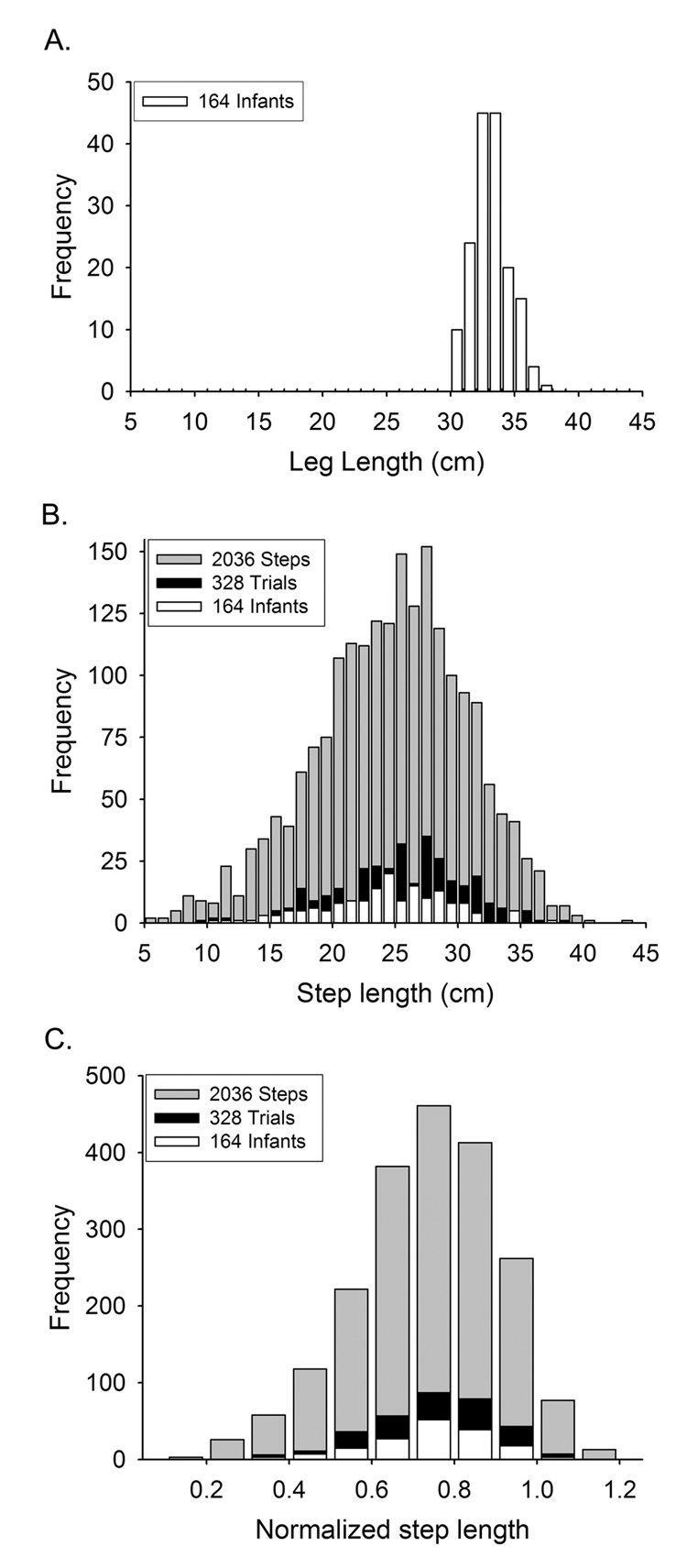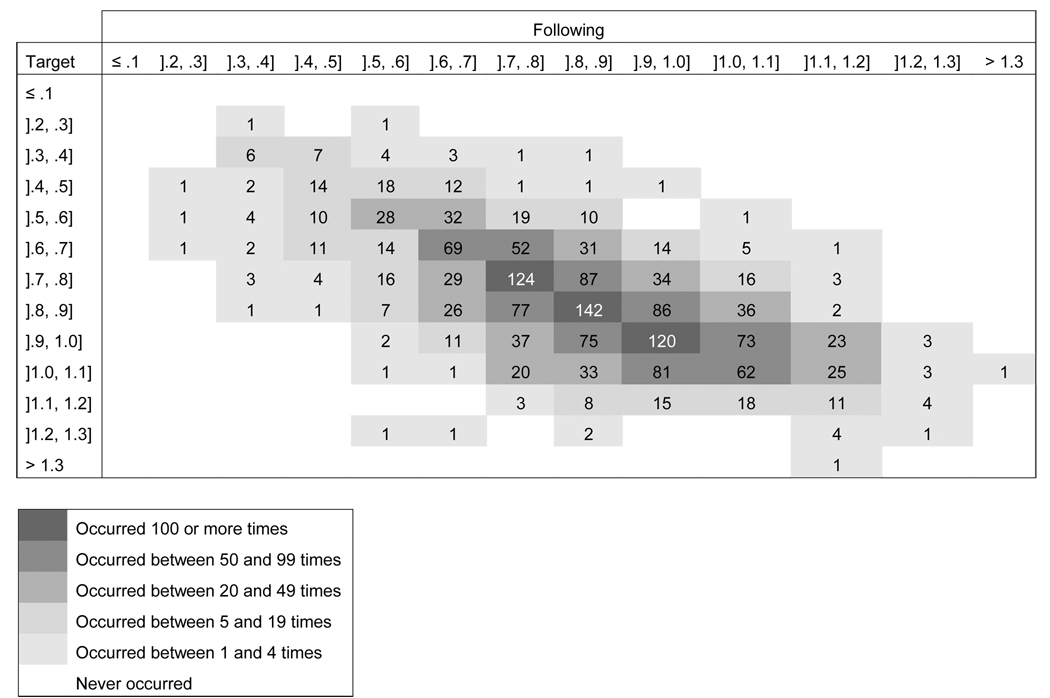Abstract
Traditionally, infant walking is characterized by small steps, attributed to limited balance control and strength. However, analyses of individual steps revealed that infants occasionally take large steps exceeding their leg length. These large steps provide evidence of advanced balance control and strength.
Keywords: Infancy, Motor development, Locomotion, Walking, Step length, Individual differences
For decades, researchers have used step length—the distance between consecutive steps—as a primary marker of developmental change in infant walking. Infants’ footfalls have been recorded with simple, homely methods such as movies of foot pressure against a glass plate (McGraw & Breeze, 1941) and footprints obtained with graphite (Shirley, 1931), talcum powder (Scrutton, 1969), and ink-stained tabs (Adolph, Vereijken, & Shrout, 2003). Developmental changes in step length have likewise been documented with more sophisticated technologies such as high-speed film (Burnett & Johnson, 1971), pressure-sensitive mats (Garciaguirre, Adolph, & Shrout, 2007), and force plates (Bril & Brenière, 1992).
Across generations of researchers and various methods of measuring gait, findings are remarkably consistent. New walkers characteristically display extremely short step lengths (~12 cm), shorter even than the lateral distance between their legs (~15 cm). Step length increases rapidly over the first few months of independent walking (~25 cm) and is accompanied by increases in velocity (from ~25 cm/s to ~80 cm/s). The standard explanation for poor performance in new walkers is that initially tiny steps reflect poor balance control and limited strength in the muscles used to support and stabilize the body. Increased step length is attributed to greater control of front-to-back disequilibrium and more efficient strategies for forward propulsion (e.g., Bril & Brenière, 1992). In other words, infants develop the ability to support the body and maintain balance on one leg while the other leg swings forward.
The standard practice for reporting measures of walking skill is to average data over trials within each session for each infant. Although researchers typically collect multiple trials, each consisting of multiple steps, data for individual steps and trials are rarely reported. By averaging data, previous work ignored the range in individual ability. However, extremes in performance can highlight the extent of infants’ balance control and strength. The current study therefore explored the range in infants’ capabilities.
Method
Footfall data were collected from 164 (87 boys, 77 girls) 14-month-old infants (± 2 weeks; M = 14.01 months). In a structured interview (Adolph et al., 2003), parents reported infants’ walking experience, dating from the first day they walked 10 feet independently. Experience ranged from 4 to 187 days (M = 71.40 days). Walking onset date was not available for one infant. As shown in Figure 1A, infant’s leg length (from hip to ankle) ranged from 30.80 to 37.70 cm (M = 33.69 cm). Infants were predominantly White and middle-class.
Figure 1.

Frequency histograms of (A) leg length, (B) step length, and (C) normalized step length. White bars denote data for each infant (averaged over steps and trials). Black bars denote data for each trial (averaged over steps). Gray bars denote data for each step (no averaging).
Data were collected using a gait carpet (26 girls, 26 boys) or inked footprints (51 girls, 61 boys) as described in previous work (Adolph et al., 2003; Garciaguirre et al., 2007). We found no differences between the two methods, so data were combined for analyses. The gait carpet (Gaitrite, Inc., www.gaitrite.com) was a pressure sensitive rubber mat (3.66 × 0.89 m; 0.64 cm spatial resolution; 80 Hz temporal resolution) that registered the location and time of each footfall. Step length (distance between consecutive steps) and velocity (distance/time over the entire walking sequence) were calculated based on the x-y coordinates and the first and last sensors activated with each footstep. With the footprint method, infants walked over a strip of butcher paper (3.70 × 0.76 m) wearing inked tabs on the bottom of their shoes at the heel and third toe, leaving behind a trail of colored footsteps, from which step length was calculated. For 8 infants, velocity was measured from video. Normalized step length was calculated by dividing infants’ step length by their leg length, thus controlling for differences in infants’ limb length.
With both methods, infants walked toward their parents who encouraged them by offering toys and treats. Coders viewed videotapes of each trial to verify that walking sequences did not include gait disruptions (stops, trips, cross-steps, etc.). Coders also eliminated the first and last few steps of each trial where infants were speeding up and slowing down. Each infant contributed two trials (4 to 22 steps) for test-retest reliability; only 6 of the 328 trials had only 4 steps.
Results and Discussion
When we averaged step length and velocity over trials for each infant, we replicated previous findings with 14-month-olds. As shown by the white bars in Figures 1B and 1C, infants’ steps were generally short (M = 25.20 cm, range = 10.02 – 37.25) and smaller than their leg length (M normalized step length = .75, range = .31 – 1.09); velocity was relatively low (M = 79.81 cm/s, range = 21.99 – 133.46). Furthermore, walking experience predicted longer, faster steps. Walking experience correlated with step length (r(161) = .51), normalized step length (r(161) = .51), and velocity (r(57) = .68), all ps<.001. Infants with higher velocities took longer steps. Step length and normalized step length correlated with velocity: both r(58) = .93, p<.001.
Figure 1B shows that the range of step lengths increased considerably when data were reported for each trial (averaged over the steps in each trial rather than averaged over the two trials in each session) and for individual steps (no averaging): range = 9.45 – 38.18 and 5.71 – 43.76 for trials and steps, respectively. The tiniest steps (< .5 of leg length) were produced by the 55 infants with the shortest durations of walking experience (M = 83.04 days, SD = 37.60 days). Most important, when analyzing individual trials and steps, we found that infants occasionally took large steps, where step length actually exceeded leg length as illustrated by the right-most bars in Figure 1C. Infants who produced normalized step lengths greater than 1.0 – in other words, steps longer than their leg length – had more walking experience (M = 92.76 days, SD = 38.16) than infants who did not (M = 64.23 days, SD = 39.95), t(161) = 4.00, p<.001, corroborating that increased step length is a sign of improvement in the development of walking.
Normalized step lengths greater than 1.0 were rare relative to the prevalence of shorter steps: Of the 2,036 steps in the dataset, only 4.5% exceeded infants’ leg length. However, of the 164 infants, 25.6% displayed normalized step lengths greater than 1.0 at least once, and 14.6% did so multiple times indicating that many infants are able to take exceedingly large steps.
Moreover, several lines of evidence suggest that large steps reflect more balance and strength than had previously been supposed for infant walkers. First, infants did not fall as if they had lost control after taking steps that exceeded their leg lengths. Rather, they built up adequate speed for the large steps and then slowed down to stop at the end of the runway. Trials including normalized step lengths greater than 1.0 had higher velocities (M = 104.20 cm/s, SD = 14.12) than trials that did not (M = 74.07 cm/s, SD = 23.36), t(117) = 6.25, p<.001. Second, large steps most often followed prior steps of a similar length, suggesting consistency at a step-to-step level. Figure 2 is a transitional frequency matrix of normalized step lengths for each step and the step that followed. The dark band of steps along the diagonal of the table illustrates the step-to-step consistency. Finally, normalized step lengths greater than 1.0 occurred at M = 72% (SD = 23) of the step sequence, indicating that infants had to first build up speed before taking a large step.
Figure 2.
Transitional frequency matrix of normalized step lengths for each step (target) and the step that followed (following).
In summary, an obvious peril of averaging data is that extremes in individual abilities will be obscured. In this case, analyses of individual steps showed that many infants in their first few months of walking are capable of occasionally supporting their body and maintaining balance on one leg while the other leg moves a distance greater than their leg length. A century-long tradition has characterized infant walking with small step lengths; this finding, however, reveals an additional facet of infants’ abilities. Previous studies of normalized step length in infants relied on averaged data and reported values below 1.0 (e.g., Chang, Kubo, Buzzi, & Ulrich, 2006; Ivanenko, Dominici, Cappellini, & Lacquaniti, 2005; Scrutton, 1969). Normalized steps larger than leg length were deemed possible only in supported infant walking (Ivanenko et al., 2005) and in older children (Stansfield et al., 2003). Comparisons cannot be made with studies normalizing step length by height (e.g., Brenière & Bril, 1998) because the ratio of leg length to height varies across individuals (Stansfield et al., 2003). The traditional reliance on averaged data overshadowed infants’ potential to demonstrate performance requiring advanced balance control and strength.
Acknowledgements
This research was supported by NICHD Grant HD33486 to Karen E. Adolph. We thank Jessie S. Garciaguirre for her help in analyzing the data. We also thank the infants and their parents for their participation and the members of the NYU Infant Action Lab for their assistance with data collections and coding. A fuller report of this work is available upon request.
Footnotes
Publisher's Disclaimer: This is a PDF file of an unedited manuscript that has been accepted for publication. As a service to our customers we are providing this early version of the manuscript. The manuscript will undergo copyediting, typesetting, and review of the resulting proof before it is published in its final citable form. Please note that during the production process errors may be discovered which could affect the content, and all legal disclaimers that apply to the journal pertain.
References
- Adolph KE, Vereijken B, Shrout PE. What changes in infant walking and why. Child Development. 2003;74(2):475–497. doi: 10.1111/1467-8624.7402011. [DOI] [PubMed] [Google Scholar]
- Brenière Y, Bril B. Development of postural control of gravity forces in children during the first 5 years of walking. Experimental Brain Research. 1998;121:255–262. doi: 10.1007/s002210050458. [DOI] [PubMed] [Google Scholar]
- Bril B, Brenière Y. Postural requirements and progression velocity in young walkers. Journal of Motor Behavior. 1992;24(1):105–116. doi: 10.1080/00222895.1992.9941606. [DOI] [PubMed] [Google Scholar]
- Burnett CN, Johnson EW. Development of gait in childhood. Part I: Method. Developmental Medicine and Child Neurology. 1971;13:196–206. doi: 10.1111/j.1469-8749.1971.tb03245.x. [DOI] [PubMed] [Google Scholar]
- Chang C-L, Kubo M, Buzzi U, Ulrich B. Early changes in muscle activation patterns of toddlers during walking. Infant Behavior and Development. 2006;29(2):175–188. doi: 10.1016/j.infbeh.2005.10.001. [DOI] [PMC free article] [PubMed] [Google Scholar]
- Garciaguirre JS, Adolph KE, Shrout PE. Baby carriage: Infants walking with loads. Child Development. 2007;78(2):664–680. doi: 10.1111/j.1467-8624.2007.01020.x. [DOI] [PubMed] [Google Scholar]
- Ivanenko YP, Dominici N, Cappellini G, Lacquaniti F. Kinematics in newly walking toddlers does not depend upon postural stability. Journal of Neurophysiology. 2005;94:754–763. doi: 10.1152/jn.00088.2004. [DOI] [PubMed] [Google Scholar]
- McGraw MB, Breeze KW. Quantitative studies in the development of erect locomotion. Child Development. 1941;12:267–303. [Google Scholar]
- Scrutton DR. Footprint sequences of normal children under five years old. Developmental Medicine and Child Neurology. 1969;11:44–53. doi: 10.1111/j.1469-8749.1969.tb01394.x. [DOI] [PubMed] [Google Scholar]
- Shirley MM. The first two years: A study of twenty-five babies. Minneapolis: University of Minnesota Press; 1931. [Google Scholar]
- Stansfield BW, Hillman SJ, Hazlewood ME, Lawson AM, Mann AM, Loudon IR, Robb JE. Normalisation of gait data in children. Gait & Posture. 2003;17:81–87. doi: 10.1016/s0966-6362(02)00062-0. [DOI] [PubMed] [Google Scholar]



